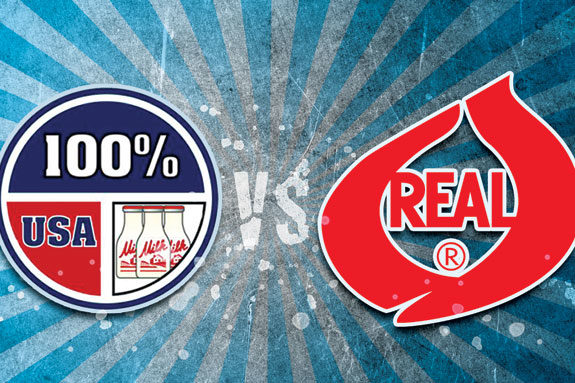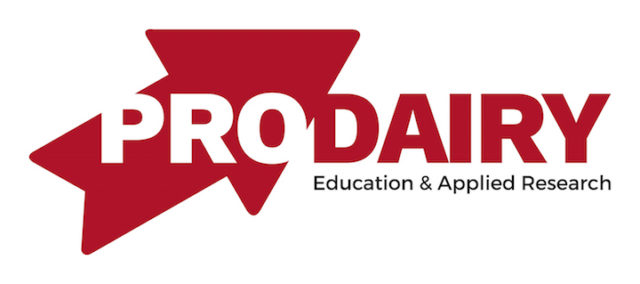The National Dairy Producers Organization hopes to win over processors, grocers and consumers with a new logo that touts products made entirely in the U.S. The group’s “100 percent USA” seal was trademarked earlier this year, and leaders of the organization are now trying to persuade processors to use it on their products.
None had signed agreements to use the new logo as of mid-April.
“There’s a lot of interest and a lot of intrigue, but I haven’t gotten anybody to pull the trigger,” Gary Genske said in a telephone interview from the East Coast, where he was promoting the organization’s agenda this spring.
Genske, who is treasurer of the National Dairy Producers Organization , had meetings scheduled with dairy producers and processors in Pennsylvania, Virginia and New York.
He had already visited Dean Foods in Dallas to promote the new label, and he plans to devote more time to such efforts now that tax season is over.
Genske is a certified public accountant from Costa Mesa, California, and a partner in two dairy farms, one in New Mexico and another in Virginia.
Established in late 2010, the NDPO hopes to influence national dairy policy, with the primary goal of increasing producers’ profitability.
The group hopes its 100 percent USA logo will soon appear on a variety of dairy products including milk, cream, yogurt, ice cream and butter.
If the new label does catch on, it could be a big boon to the fledgling organization. Companies using it will be required to pay royalties of one-half of 1 percent on all gross sales.
The NDPO also wants to make similar 100 percent USA labels available for other food products. The group announced in February that it had secured trademarks for use by the beef and citrus (orange) industries.
Companies that use the 100 percent USA seal must certify that the products are not only made in America, but that the main ingredients are produced in the U.S., in accordance with U.S. laws.
The NDPO has been highly critical of the use of imported milk protein concentrates (MPC) in the making of some U.S. dairy products.
Imported MPC displaces U.S. milk, and processors aren’t required to let consumers know whether the product was inspected and regulated to the same standards as U.S.-made product, NDPO officials contend.
Genske sees a lots of potential in the new USA logos.
Consumers appear willing to pay more for products labeled “100 percent USA” compared to products without a symbol, according to a survey conducted by Summit Research.
Among those willing to pay more, the price premium was generally about 5 percent for key dairy categories, the survey found.
The whole issue of food labeling and country of origin has been a hot topic lately.
The National Milk Producers Federation announced on March 28 that it had taken over management of the REAL Seal from the United Dairy Industry Association.
Genske doesn’t believe it was a coincidence that NMPF took over management of the REAL Seal when it did. He thinks it was a reaction to his organization’s launch of the 100 percent USA label.
“They (NMPF) are saying that the REAL Seal will assure Americans that their products are from America, (but) that’s not what the REAL Seal was all about,” Genske said. “The REAL seal was real dairy versus imitation dairy.”
The REAL Seal was created about 35 years ago and has become one of the most recognizable symbols in the food industry.
The transfer of the iconic seal to NMPF management was merely “an opportunity that presented itself,” organization spokesman Chris Galen said in an interview.
The NMPF plans to promote use of the logo as a way for processors and retailers to differentiate American-made dairy foods from imports and imitations.
“What we have to do is figure out how we are going to try to bolster and revitalize the use of (the seal),” Galen said.
“Obviously, a number of the member co-ops of National Milk are either existing or potential users of the REAL Seal, so we think there is a lot of synergy there.”
A dairy country-of-origin labeling (COOL) bill re-introduced in the U.S. Senate late last year by Sen. Al Franken (D-MN) doesn’t appear to be going anywhere, Galen said.
“From our standpoint, we’ve already got a country-of-origin label product in the form of the REAL Seal.
We just need to make sure it’s used to its full capacity,” he said. “That’s our challenge and that’s our opportunity.”
The NMPF has not supported dairy COOL legislation in the past, and leaders of the organization don’t expect it to be included in the next farm bill.
“If we can build on the use of the REAL seal, then we don’t necessarily have to mandate country-of-origin labeling, which is proving to be a sticky wicket in the meat industry,” Galen said. PD
Wilkins is a freelance writer based in Twin Falls, Idaho.










